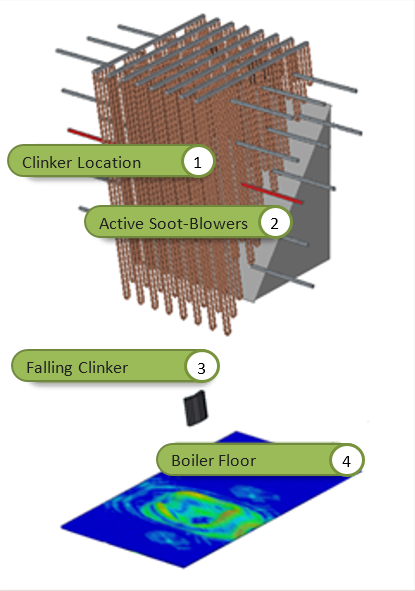Author: Tim Carlier – Integrated Test & Measurement (ITM), LLC, Ryan Welker – Integrated Test & Measurement (ITM), LLC
Industry: Pulp & Paper/Energy Generation/Industrial
Novel Clinker Detection System Reduces Boiler Fouling While Boosting Sootblowing Efficiency
A proprietary monitoring technology developed by Integrated Test & Measurement is introducing a brand new approach to address “fouling” in coal-fired power plants as well as the pulp and paper industry.
ITM’s solution, the Clinker Detection System – Patent Pending, has proven it can boost sootblowing efficiency, save steam and curb maintenance headaches in plants by putting a novel data-collection technology to work.
Fouling occurs inside black-liquor recovery boilers (as part of the pulping process) and in coal-fired utility boilers when incombustible byproducts adhere and insulate furnace components — the steam-generating tubes in the boiler’s superheater — thereby reducing steam production and even halting operations altogether to allow for maintenance cleanings.
For decades, these industries have relied on sootblowers — long rotating lances that are inserted through the superheater tubes during combustion — to blow off soot and dislodge clinkers, the masses of ash deposits that form around superheater tubes. Clinkers, some of which reach the size of a small car, can damage components as the masses plummet up to 150 feet and crash to the boiler floor.
As the name implies, ITM’s Clinker Detection System (CDS) uses the falling masses themselves to inform operations and ultimately boost efficiencies by collecting impact data as clinkers impact with the boiler floor. The key to the technology involves mapping and instrumenting the floor with industrial sensors, which measure the size and frequency of deposits that impact while also identifying which sootblower caused the clinker to fall.
“So now you know in your boiler where your fouling is occurring,” says ITM President Tim Carlier. “You also know what your rate of removal for each given sootblower is. If it is very high, then you say, ‘maybe we need to increase the number of blows there. If it is very low, you back it off.”
Carlier says the industry has been sootblowing based on educated guesses, but those who implement ITM’s Clinker Detection System can begin sootblowing using hard data.
“Right now they are really blind as to when or where to run sootblowers,” he says. “It is like painting in the dark. Considering up to 6 percent of the steam generated by a boiler is used for sootblowers, if we can just decrease the sootblowing by a small percentage, that’s a lot of savings, especially when you add it up over a year. We are playing with big dollars in terms of return on investment.”
ITM points out that optimizing sootblowing doesn’t only save money, it also has a significant environmental effect as plants don’t have to burn as much fossil fuel to generate electricity since they will consume steam more efficiently. The CDS can be used to gauge the effectiveness of other boiler cleaning tools, too, including sonic horns, pulse-detonation cleaning events as well as chill-and-blow cleaning events.
During chill-and-blow cleaning events, the boiler is taken offline while plant operators cool things down and run the sootblowers to further clean the superheater, however, they typically have no way of knowing how long to perform the operation. With the CDS, it is clear when the masses stop falling from the superheater tubes and hitting the boiler floor that the operation can end and the boiler can get back online and generating steam.
Finally, by identifying the location where the biggest and most frequent clinkers impact the boiler floor, the Clinker Detection System can identify what areas of the superheater are generating damaging clinkers, and operators can then increase the frequency of sootblowing in that area to reduce the size of the clinkers and ultimately mitigate the risk of damage that leads to expensive repairs.
Author Information: For more information on this Case Study or other ITM Industrial Monitoring Systems, contact: Ryan Welker – Integrated Test & Measurement (itm), LLC – ryan.welker@iTestSystem.com





